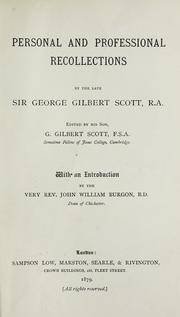Recollections
Sir George Gilbert Scott had probably found that most of his family knew little about his professional achievements. But, according to his nephew, he ‘delighted in telling stories of old Gawcott days, & of the odd doings & sayings of the country people there’. So, on the way back to London from Brighton, after the death of his sister Mary in 1864, he set about writing an account of his work and childhood. After filling seventy-five pages of a leather-bound notebook, which he always carried, he concluded:
I have been cheering myself today after the death of my dear sister while travelling by writing the above reminiscence which I know she would have enjoyed to do herself, but grief will return & I must stop.
He must have very soon recovered his composure as six weeks later, by 10 March 1864, he had filled more than 750 pages in two matching notebooks with a close-packed pencil manuscript about his life and work. Sir George Gilbert Scott wrote at the rate of more than 1,000 words a day in a lucid and ordered manner. His handwriting varies considerably, presumably indicating whether he was at a desk or travelling, and some words have been subsequently overwritten to make them more legible. At the start Scott says that the purpose of his writing was to acquaint his children with the particulars of his life before the times that they could remember. When he concluded the first part of his Recollections on 20 March 1864, he ominously commented that the death of his sister Mary Jane:
was the first breach in our immediate family circle of brothers & Sisters since the death of my dear Brother Nathaniel in 1830. A space of nearly 34 years How much do we owe to Almighty God for so long sparing us from so bitter a grief!
The double blow of the deaths of his sister Euphemia and son Albert made him ‘re-open my book after closing it for twelve months’ on 23 March 1865, with a particularly morbid account of Albert’s death which extended into a third notebook. He recorded the death of his brother Samuel King Scott on 17 June 1865 but after that he wrote nothing for seven years until March 1872, when he recorded his own wife’s death along with other family bereavements. Again he used the writing as a means of pouring out his grief. He started on 10 March 1872, two weeks after Caroline died, and by the end of March had written over 130 pages about his feelings towards Carry, betraying perhaps his own guilt at his treatment of his utterly devoted wife. He opened a fourth notebook on 8 August 1872 with the words, ‘May God bless what I have to record in this book’. In 1873, according to George Gilbert junior, his father drew up directions for the publication of his Recollections after his own death. He said that although they were originally intended for the information of the family, ‘but as the work progressed the scope of it became enlarged’. It seems likely that this was when Scott went through the four notebooks over-writing the illegible words and adding some instructions about publication. For instance, at the conclusion of his account of the Foreign Office affair he said: ‘I must however privately warn my sons against publishing what may get them into ill odour with authorities’, and it is noticeable that after 1870, when Scott drew up instructions for publication, the manuscript contains no more highly emotional passages.He continued into a fifth notebook in November 1877, and his last entry, dated January 1878 only two months before his death, was his view on the so-called Queen Anne style, the ‘vexatious disturber of the Gothic Movement’. It is also a lucid summation of the development of his architectural philosophy from when he was awakened from his slumber ‘by the thunder of Pugins writings’ to wishing ‘the Queen Anneites’ all success, and forms an extraordinarily fitting conclusion to his Recollections.His eldest son edited the notebooks, in accordance with his father’s wishes and had them published as a single volume in 1879. In doing so, he omitted most personal material and altered and abbreviated much of his father’s text. The British Architectural Association hold’s Scott’s original hand-written notebooks.

